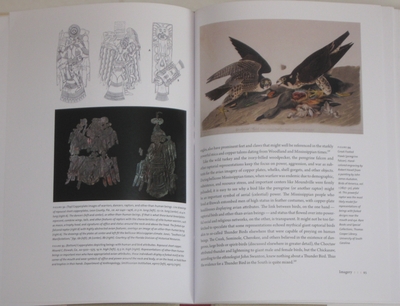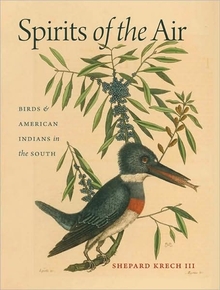Reviewed by Grant McCreary on April 27th, 2009.
For many of us birders, our lives revolve around birds. Business trips become opportunities to bird new places, most of the books we read involve birds (it can’t be just me!), and wherever we are and whatever we are doing, we can’t help but notice the birds around us. But everyone else seems to be completely oblivious of them. Has it always been this way? What exactly have other societies thought about birds? In this book, the author asks such questions about the Indians of the American South.
Spirits of the Air is a synthesis of what is known about the Southern Indians’ connection with birds. The “South” here is not precisely defined, but is the general area of the southeastern United States, roughly equivalent to the Confederate core.
First, the author presents an overview of the bird life of the South as it was in the sixteenth through nineteenth centuries. Indians, of course, were present much earlier than that, but written records of birds don’t appear until the European explorers and colonists arrived. Accounts of the region’s birds, as told by these settlers, give the reader an idea of what the avian life was like during this time. If these accounts are to be believed, then the South must have been teeming with birds! As the author summarizes:
From today’s vantage point nearly two hundred years later, the numbers are phenomenal. Species common today were abundant in Audubon’s day, and ones uncommon, rare, or threatened now were common then.
I have lived in this region my entire life, and these accounts are almost beyond belief. I have seen great congregations of ducks, as many of these sources mention, but they are very concentrated in protected areas (such as Merritt Island National Wildlife Refuge). I can’t imagine such flocks occurring throughout the region.
Representations of Indians, from Colonial times through the present, usually have one thing in common – feathers. Many of them did, in fact, use feathers as decoration. But that isn’t all; they were also used for clothing, blankets, ceremonial items, and fletching arrows. Some even used them for wiping after meals, like a napkin. Speaking of food, birds were, of course, eaten. The Wild Turkey was the most prominent, but many, many others were also known to be consumed, including waterfowl and Passenger Pigeons.
But Native Americans also had an association with birds beyond the utilitarian. In this book, Krech shows how birds and bird-like characters figured prominently in art, decoration, spirituality, politics, and stories.
Perhaps the most interesting thing was discovering which birds played a role in the Indian cultures. Eagles (both Golden and Bald) and turkeys aren’t really surprising. But others, such as the Yellow-breasted Chat, were very surprising. Conversely, the same could be said about the species that were not visible in their culture. As expected, most sparrows (and other “little brown jobs”) and migrants didn’t have much of a role. On the other hand, where was the Swallow-tailed Kite? It is a stunning and impossible-to-overlook bird that ranged throughout the region (at least it did then), but somehow it does not seem to have been culturally significant.
Birds clearly had roles in Indians’ lives, but the reverse is also true. How, and whether, Indians impacted bird populations is also explored here.

This book is profusely illustrated with images of birds, Indians, and artifacts. Most of the bird species mentioned in the text are also shown in paintings by Audubon, Alexander Wilson, Mark Catesby, and a few others. Paintings and photographs of Indians depict examples of bird use (especially feathers).
The writing is more on the academic side, but not stuffy by any means. The author has a penchant for understatement, which I appreciated. I even got a chuckle out of some instances. However, the sentences seemed a bit awkward at times, making it difficult to read. I don’t know if it was just me, but I had to reread too many passages to understand what was being communicated.
A less subjective issue is factual errors. I picked out several misstatements concerning birds. However, these mistakes are minor and inconsequential to the purposes of the book. Regardless, the text could have used some closer proofing in regard to birds.
Recommendation
This is a well-researched and informative exploration of the association between Indians and birds in the American South. I would recommend it to anyone who is interested in both birds and Native Americans.
Further, any birder living in the South, or anyone strongly interested in this region’s birds, should find Spirits of the Air of interest. This is what drew me to this book, and I was not disappointed. It goes without saying that I learned a great deal about the Indians who once lived here, but I also discovered much about the birds that lived alongside them.
Disclosure: I get a small commission for purchases made through links in this post.
Disclosure: The item reviewed here was a complementary review copy provided by the publisher. But the opinion expressed here is my own, it has not been influenced in any way.





Interesting. I had not been aware of this title. Thanks for bringing it to my attention.
I’m a birdlover myself..love’em more than ppl…:) They just don’t give them enough credit as they are such special creatures. I am owned by a nenday, a cockatiel and a parakeet…
The Birdlady 😉
…and I forgot to mention that although in the heart of NY, in Queens to be more precise, we have cardinals in the garden….:) AND as everyone knows lots of parrots in certain areas such as Maspeth, the airport areas and pretty sure more than that..:)